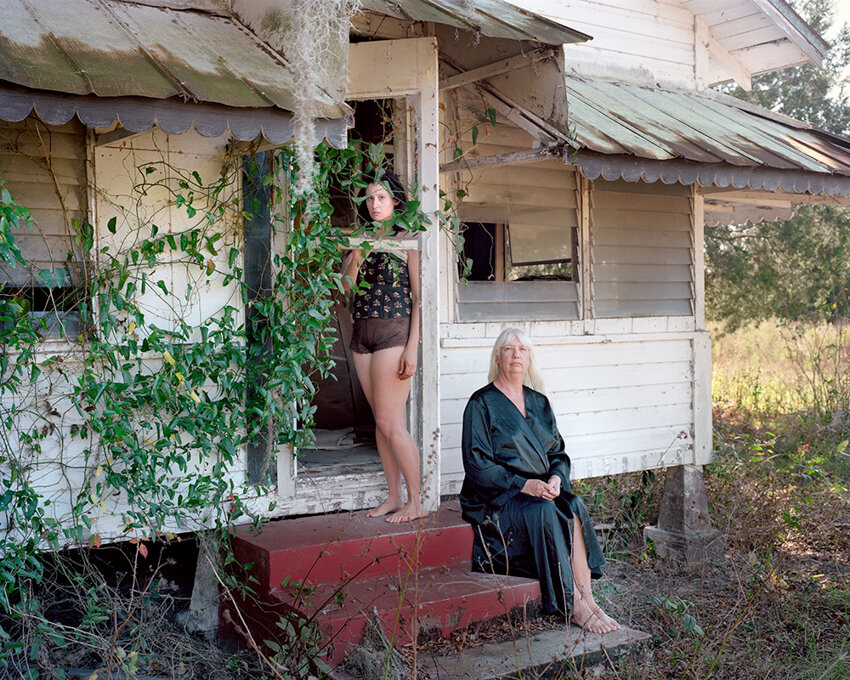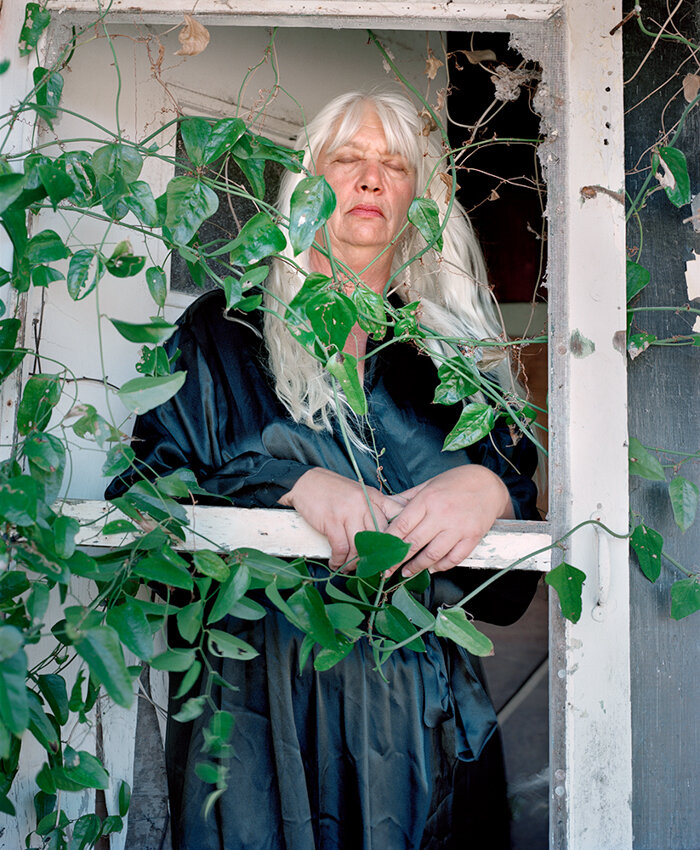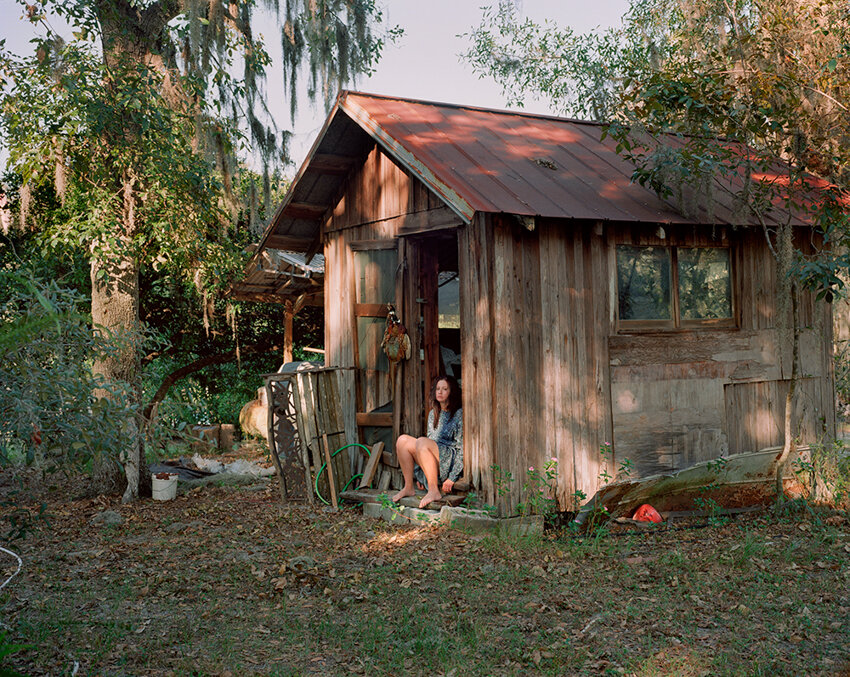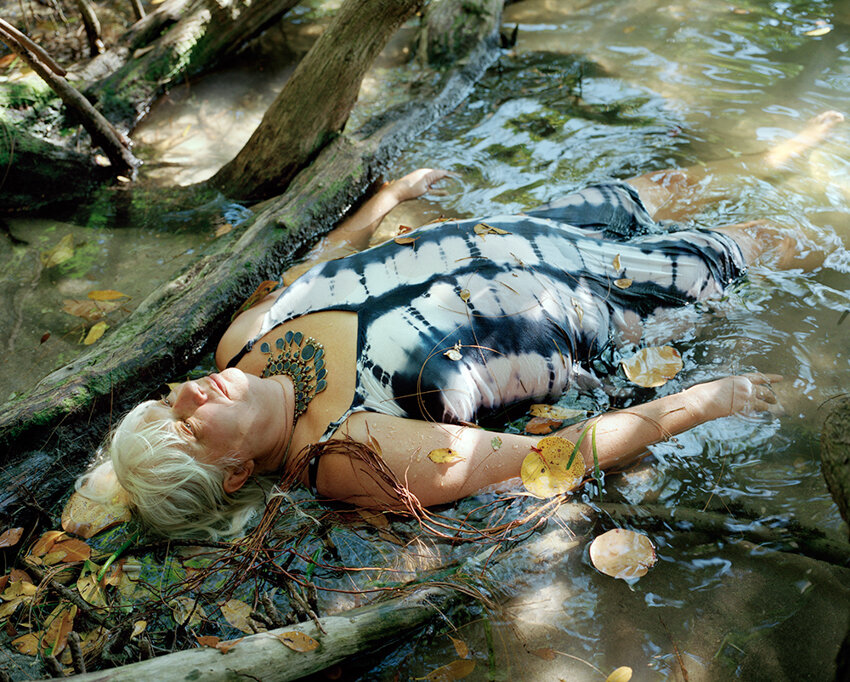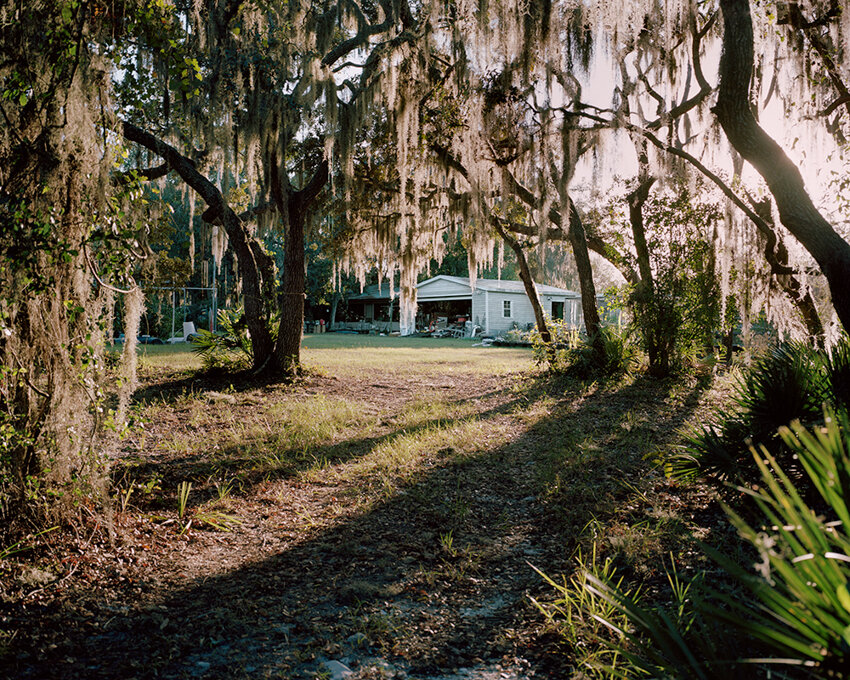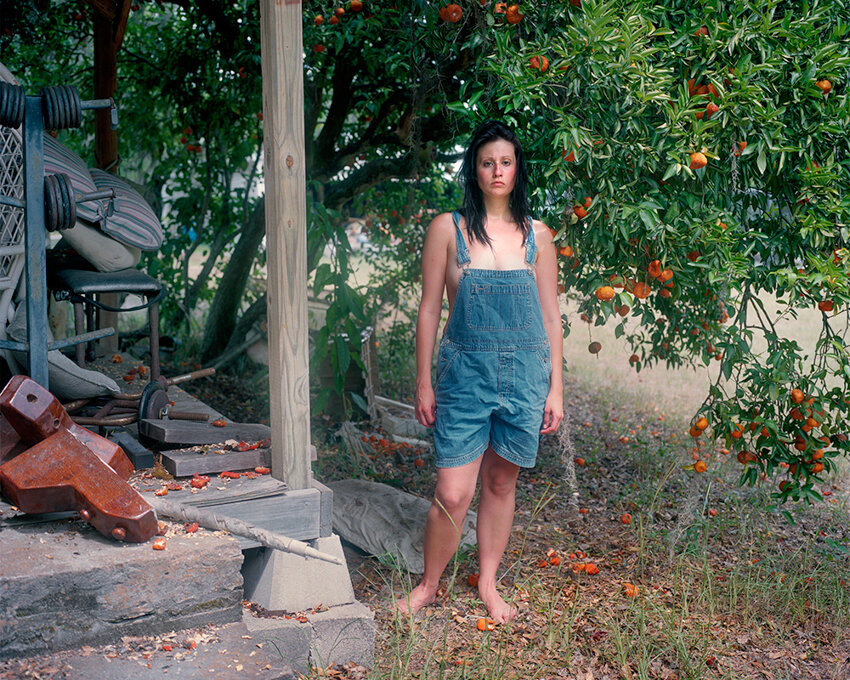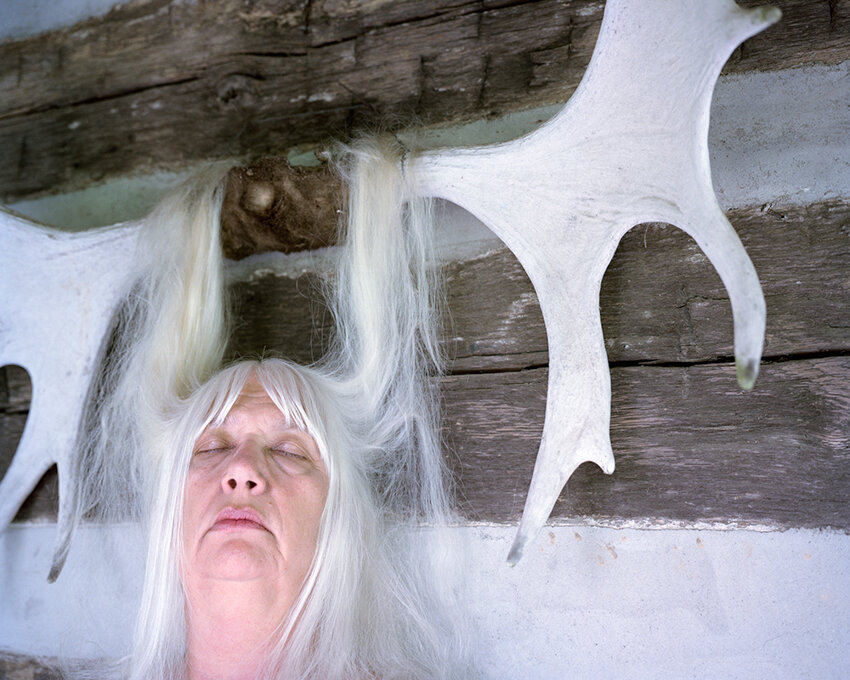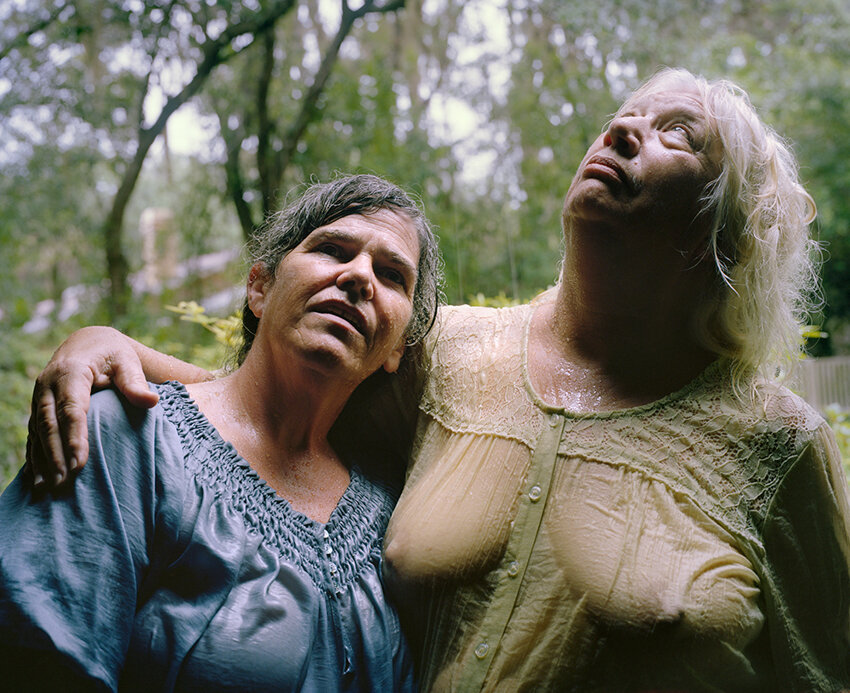Q&A: Noelle McCleaf
By Hamidah Glasgow | February 27, 2020
Noelle McCleaf is a photographer exploring themes of memory, relationship, and identity in the landscape of South Florida. She is currently lives and works in Venice, Florida as an exhibiting artist and Professor of Photography at the Ringling College of Art and Design.
Hamidah Glasgow: I've long been an admirer of your work. Your work has an unusual and refreshing quality of creating deeply emotional images and images that convey a wry sense of humor. The richness of your palette is delicious, and I'm always eager to see more.
Both of your series, A Bee in Her Bonnett and Evie Lou and Laura Jane, are distinctly feminist. The way you portray the subjects without artifice or ornamentation is refreshing and a bit unsettling. How did these two bodies of work begin?
Owl Mask from Evie Lou and Laura Jane
Noelle McCleaf: When I was living in Minnesota, I created a project called Convergence. Convergence was a series of self-portraits derived from the turbulent time of transition from childhood to adulthood. I wrote flash-fictions and transformed the photographs into new narratives, as an adult woman reclaiming and retelling her history. My mother was very much a part of the stories I wrote to inspire Convergence, but I didn't physically bring her into the images until I visited her in South Florida.
The change of climate was drastic, especially in the winter--and it shifted my color palette from the cold anemic hues of Minnesota to the warm evening light of South Florida. During our visits together, we recalled of our familial history, told stories, and shared time together in the landscape. A Bee in Her Bonnet was born out of these visits. Many of the objects (and figures) present in the landscape and are used as a vehicle for the narrative. I was born and raised in Virginia by an iron-willed single mother with reverence for the land, and this is very present in the images.
After A Bee in Her Bonnet, I was eager to focus on a new relationship and move myself out of the frame. Evie Lou and Laura Jane was a natural progression, in that it was the next closest relationship I wanted to explore—my mother (Evie Lou) and her best friend (Laura Jane). I was very close with these two women, and they had been an inspiration to me for some time. I deeply respected their service to the natural world, their rejection of traditional standards of beauty, and their willingness to collaborate by lending themselves to be photographed.
HG: I'd like to talk a bit about your portrayal of Evie Lou and Laura Jane's rejection of traditional standards of beauty and their place in the wildness of the land. In our culture, these are both delicate matters as adherence to beauty standards go deep and permeates our lives. Men that disavow male standards of beauty are generally seen as rugged and individualist. Women who do the same are typically regarded as "letting themselves go" or other derogatory terms.
How did you approach these issues, and what did you think about while making the images of them?
NM: Evie Lou and Laura Jane are storytellers that source their spirituality from the natural world. Evie (my mother) is a trained survivalist, meaning she practices primitive skills such as animal tracking, fire building, and sustainability. She spends much of her spare time volunteering for a local wildlife center. Laura Jane's grandmother descends from the Blackfoot Native American tribe, and she worked for many years as a hospice nurse. They both share the neo-pagan belief that women go through three life stages--the stages of maiden, mother, and crone. The word crone has been used throughout most of history in a derogatory way to describe an old woman or a witch. However, they fully embrace the term—Laura has a tattoo of triple moons on her forearm that symbolizes this idea.
I was first drawn to photograph them because I spent many hours with them, listening to their stories, in awe of their carefree nature and charisma.
After we'd chat for an hour or so, I would ask them to re-create a moment from one of their stories, or simply walk around and photograph the land that Laura lives on in Myakka City, Florida.
After many of our conversations, I began to transcribe our conversations as a source for picture-making. I also wanted to bring their voices into the project.
One of our most intense conversations was about the death of mothers. They both agreed that you don't fully come into yourself as a woman until your mother dies. This was a shocking and honest revelation since my mother is such a dominant force in my life.
During one of our conversations, Laura Jane said she saw her divine reflection in my mother (Evie Lou), so I looked for a mirror around the property to create an image of Laura with my mother's reflection in it. This became the image titled Divine Reflection. I photographed them participating in rituals, healing ceremonies, and created portraits of them in the landscape. As a photographer and feminist, I found their story to be refreshing and unique. So many women spend their lives attempting to retain an impossible youthfulness, and they have found a source of power and strength in their years.
Divine Reflection from Evie Lou and Laura Jane
HG: I wonder if the time you spent in Minneapolis for school informed the way you portray the environment of the south-east and Florida in particular?
NM: Yes, visually and conceptually, for sure.
Convergence helped to lay the groundwork for the work I've made in Florida. Color is an essential part of my process as it helps to drive the narrative. The work I made in Minnesota was cool-toned and cathartic, and the color palette parallels the mood. The landscape in A Bee in Her Bonnet is vastly different, but the color works in a similar way. A Bee in Her Bonnet was all shot during midsummer, so the weight of the air, the long shadows and Spanish moss, all help to accentuate the wildness of the narrative—and the wildness of a mother and daughter in a primitive landscape.
HG: When I first saw the title, Orange Crush, I expected something political but was both disappointed and thrilled that the images are a continuation of your love of your environment and the people around you. Tell me about the impetus for Orange Crush?
NM: I've spent twelve years of my adult life living in Florida, and during those years, I've been collecting photographs of people and places that draw me in. Florida is a challenging landscape to live in, in that it is very troubled politically, economically, and environmentally. Conversely, it offers those who reside here a backdrop of stunning sub-tropical species of plants and animals. This is what attracts so many to its sweet spell. Orange Crush is my love letter to Florida and the many who choose to reside here and ride out the turbulence.
HG: I haven't spent much time in Florida, and so only know of it through stories, movies, etc. You've chosen to focus on the things that you love there instead of the issues that are problematic. Is there a project in the back of your mind that looks at Florida from the perspective of the problematic issues?
NM: Orange Crush has been a great way for me to free up my shooting for a while and work on something fairly light-hearted. If I did make political work about Florida, it would be much more environmentally conscious.
I am currently working on a new project that is a continuation of my long-term focus on women's stories. It catalogs the lives of two women from my family who came of age in the early 20th century. Erma and Milly were two sisters who lived in a large two-story home together and never married or had children, which was rather unusual for the time. The images are a combination of film photographs and scanned elements. I'm exploring mountains of their belongings--old letters from suitors, photographs, personal postcards, and even dresses they wore from the Victorian era. In addition to curating the materials, I'm reading feminist literature from the time period.
HG: That sounds amazing! I'm impressed that you have those resources available to you. Someone in your family is a collector- lucky for you. Are you ready to share any of those images yet?
Beaded Tree from Evie Lou and Laura Jane
NM: I'm not ready to share anything that is fully completed yet, but I will be soon!
HG: Is Florida a place to call home for now? Do you long for another climate or landscape to make your art?
NM: Since my family lives here, it's difficult to see myself moving anytime soon.
I am worried about climate change in the state, as I'm sure many people who live in vulnerable coastal communities are. Wherever I find myself, I imagine that the land will inform my work in some way—even if the photographs move inside for a while.
HG: Thank you for your time and for sharing your work.
NM: Thank you!
All images © Noelle McCleaf



